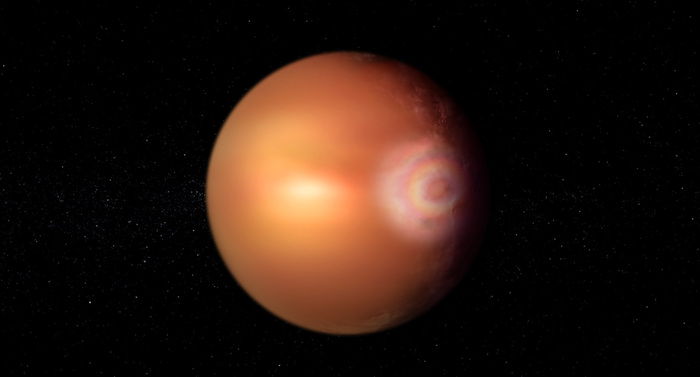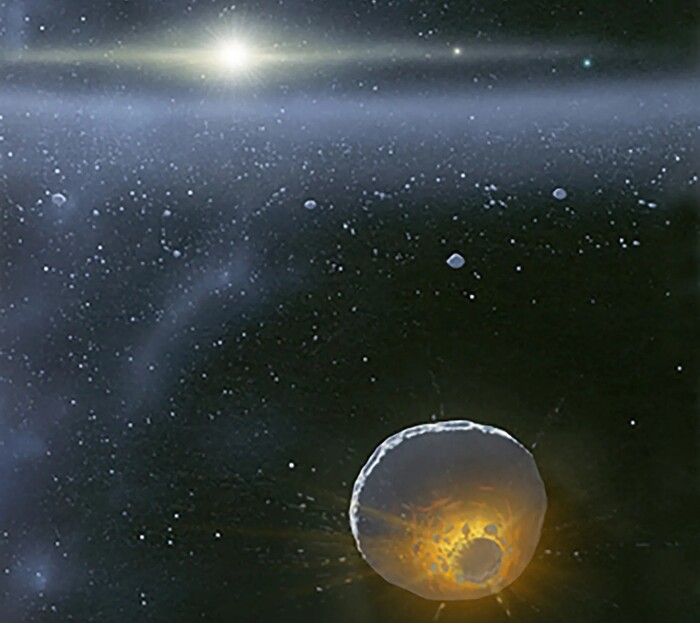By Tom Metcalfe -
NBC News
A dark planet surrounding the faint residue of a charred star about 6,000 light-years from Earth reveals what our solar system may look like at the end of its existence, astronomers say.
This distant survivor, described in a study published last week in the prestigious journal Nature,
appears to be a Jupiter-like gas giant
and provides a picture of a planetary system around a dying star, according to the research authors.
The star is a "white dwarf", the glowing stellar remains left over from the death of its "red giant" phase, when it expanded tens of thousands of times after having exhausted hydrogen fuel for its nuclear fusion reactions, and it collapsed a few hundred million years later.
The planets closest to the star may have been destroyed
, and the same fate is likely to befall our world when the Sun burns all of its hydrogen around 5 billion years from now.
Planet Earth: This is behind the 'red tide' that kills thousands of fish in Florida every year
Sept.
23, 202103: 23
"When the Sun expands in what is known as its red giant phase, it
is likely to obliterate Mercury and Venus, and possibly Earth,
" says lead study author Joshua Blackman, an astronomer at the University of Tasmania. in Australia.
Much earlier,
the Sun will have become too hot for life to exist on Earth.
Its red giant phase will cause lava lakes, broken continents and devastating explosions of intense ionizing radiation, if it does not completely fragment our planet, Blackman explained in an email.
[A former NASA astronaut criticizes space tourism after Captain Kirk's 'star trek']
But it is not all bad news:
Mars and the outer gas giants (Jupiter, Saturn, Uranus and Neptune) are expected to survive
the burning of the Sun. The detection of the distant planet orbiting a white dwarf reinforces that idea.
"Our discovery proves that the standard picture of how planetary systems evolve when their star dies is probably correct," Blackman said.
Planet Earth: For these reasons the destructive power of tropical cyclones is increasing
Sept.
2, 202102: 33
The newly found white dwarf was detected towards the center of our galaxy
by a gravitational effect called "microlensing" as it passed in front of an even more distant star.
The white dwarf's gravity made the distant star appear brighter for a few years (a brief flash in astronomical time) as its mass focused the light through the gravitational lens, said Jean-Philippe Beaulieu of the Institute for Astrophysics. de Paris, who led the research and is a co-author of the study.
A second flash of light revealed the orbiting planet
.
[A Latina stepping on the surface of the Moon? This is how this fiction from NASA projects it]
In fact, thanks to the microlensing, the white dwarf system could be detected.
Although the team tried to see it with the giant telescopes at Hawaii's Keck Observatory, it was too faint to see it.
They hope to get better results soon with the James Webb Space Telescope, which is scheduled to launch in December and will be able to directly observe the shadowed system, Beaulieu said.
Planet Earth: Children will experience three times more natural disasters than their grandparents
Oct. 3, 202101: 27
Blackman said the gas giant, whose mass is about 1.4 times that of Jupiter, orbits at a distance of between 260 and 600 million miles from the white dwarf.
Although it is likely to have formed farther than its current orbit, the host star's shrinkage after its red giant phase has not brought it close enough to fragment it, which has been theorized in some models.
"We believe that
the planet survived intact the red giant phase of the evolution of its star,
" he said.
Lisa Kaltenegger, associate professor of astronomy and director of the Carl Sagan Institute at Cornell University, said the new discovery is further evidence that
planets can survive the death of their stars.
Mars and the outer gas giants (Jupiter, Saturn, Uranus and Neptune) are expected to survive the burning of the Sun.ANDRZEJ WOJCICKI / Getty Images / Science Photo Libra
Kaltenegger, who was not involved in the latest research, was part of a team that detected another giant planet orbiting a white dwarf star late last year, the first ever seen.
However, that study showed that
the planet completes one orbit every 1.4 days
, so it is much closer to the white dwarf than Mercury is to the Sun.
The researchers say something similar is likely to happen here billions of years from now when the Sun runs out of fuel and destroys Earth and the inner planets, with
only outer planets like Jupiter surviving.
Kaltenegger pointed out that it likely formed much farther away, spiraling as the star shrank to a stop a few million miles away.
NASA launches 'Lucy' mission to search for Trojan asteroids around Jupiter
Oct. 18, 202102: 01
Taken together, the discoveries show that the outer planets, and perhaps their moons, can survive the disappearance of their stars, although their final orbits appear to depend on their circumstances, he added.
Although the remains of white dwarfs do not produce much light, they do generate enough heat for their inner planets, which implies that
life could continue to exist in such a planetary system when its star "dies"
like this, perhaps under the scabs. frosts on the moons of gas giants, such as Jupiter's Europa and Saturn's Enceladus, he claimed.



/cloudfront-eu-central-1.images.arcpublishing.com/prisa/TQ73US57UFGWTIXR7C3BS2OTIA.jpg)










